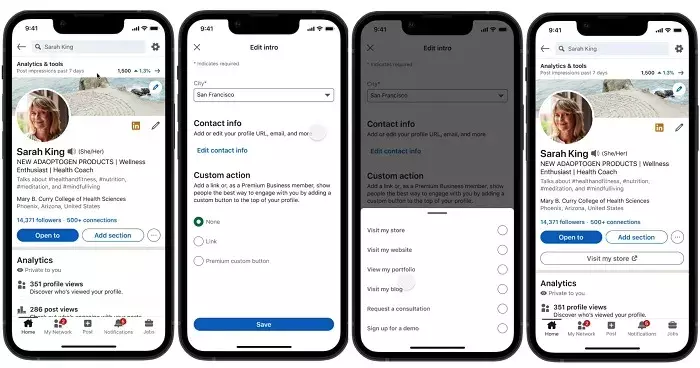In a surprising twist, LinkedIn has decided to streamline its user profile features by removing the option for users to add custom external links to their profiles. Initially introduced as a premium feature in 2023, these customizable call-to-action (CTA) buttons allowed users to create personalized prompts such as “Visit my Store” or “Explore My Website.” These buttons were not just decorative; they aimed to channel traffic from a professional networking space directly to personal or business pages, thereby enhancing user engagement.
While the intention behind this feature might have been noble, its actual impact appears to have fallen short. LinkedIn, which boasts around 175 million premium subscribers, claims to focus on features that deliver the most value to its members. Yet, the abrupt removal raises a fundamental question: did custom links truly matter to LinkedIn’s broader community, or were they simply ignored functionality that appealed more to a select few?
Evaluating User Engagement
A critical evaluation of user engagement statistics reveals that the uptake of custom CTA buttons wasn’t as robust as LinkedIn might have hoped. Feedback from users often highlighted that not many were actually leveraging their profiles to pull significant traffic. The sad reality is that while LinkedIn Premium has enjoyed an impressive growth of 50% over the last two years, the custom links feature seems to have missed the mark in terms of user adoption.
Moreover, it is essential to recognize that while a large user base exists, not all Divided attention is equal. Businesses tend to have more compelling reasons to leverage such tools, in contrast to individual users whose profiles may not have been set up for driving external traffic effectively. Thus, LinkedIn’s decision could reflect a nuanced strategy: prioritizing functionalities that cater more to business profiles rather than personal users.
The Impacts of this Change
For those who had previously added a custom link, they may breathe a modest sigh of relief knowing that their existing CTA will remain, albeit with the caveat that it cannot be altered or replaced. However, the loss of this feature for new users is concerning. The very nature of LinkedIn as a platform rooted in networking and professional advancement demands that individuals find new ways to showcase their skills and experiences. The removal of this feature feels like a step backward, limiting their ability to connect directly with the content and services they offer.
This decision strikes an interesting contrast when weighing the benefits that LinkedIn continues to roll out for premium business profiles. According to LinkedIn, Premium Company Pages, which allow for similar custom CTA buttons, generate over ten times the average clicks when compared with those available to non-paying pages. As businesses evident in the data continue to thrive with such features, it’s apparent that LinkedIn recognizes and cultivates the business side of its platform more effectively than the individual user experience.
LinkedIn’s Broader Intentions
One unspoken aspect that should not be overlooked is LinkedIn’s ambition to transition toward becoming a more versatile content platform. By catering increasingly to creators, who represent a dynamic segment within the social media landscape, the platform could be hamstrung by the presence of publicly linked content that strays too far from its professional ethos.
The question now becomes whether the removal of features like custom links is a calculated step toward ensuring that the platform remains a bastion of professionalism, reducing the risk of “questionable links” that can degrade its reputation. While eliminating the possibility for individual users to share links may bolster internal engagement, it could also alienate those looking for avenues to express their personal brand.
In the end, while LinkedIn may have good intentions behind the elimination of this feature, the broader implications represent a double-edged sword—striking a balance between community authenticity and upholding its professional standards remains a critical challenge as the platform navigates its future.


Leave a Reply